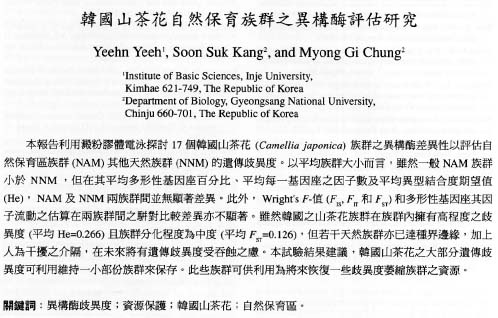Bot. Bull. Acad. Sin. (1996) 37: 141-146
Yeeh et al. — Conservation genetics in Camellia japonica
Evaluations of the natural monument populations of Camellia japonica (Theaceae) in Korea based on allozyme studies
Yeehn Yeeh1, Soon Suk Kang2, and Myong Gi Chung2,3
1Institute of Basic Sciences, Inje University, Kimhae 621-749, The Republic of Korea
2Department of Biology, Gyeongsang National University, Chinju 660-701, The Republic of Korea
(Received September 29, 1995; Accepted December 29, 1995)
Abstract. The allozyme diversity of 17 Korean Camellia japonica populations was investigated using starch gel electrophoresis in order to evaluate the levels of genetic diversity in natural monument (NAM) in comparison to other natural (NNM) populations. Although the approximate mean population size of NAM is smaller than that of NNM, the mean percentage of polymorphic loci, mean number of alleles per loci, and mean expected heterozygosity (He) were not significantly different between NAM and NNM populations. In addition, Wright's F-statistic values (FIS, FIT, and FST) and estimates of gene flow for polymorphic loci were not significantly different from each other in pairwise comparisons between the groups. Although Korean populations of C. japonica maintain high levels of genetic diversity within populations (mean He = 0.266) and the degree of population differentiation is moderate (mean FST = 0.126), the several isolated natural populations of the species in Korea, which are at the margin of the species range, coupled with habitat fragmentation by human disturbance may suffer an erosion of genetic diversity in the near future. The results of this study suggest that a large portion of genetic diversity for Korean populations of C. japonica could be conserved by maintaining a few populations. The populations could be used as resources of genetic diversity for the restoration of genetically depauperate populations in the future.
Keywords: Allozyme diversity; Conservation; Korean Camellia japonica; Natural monuments.
Introduction
Camellia japonica L., a broad-leaved evergreen woody species, is widely distributed from Taiwan northward through Ryu Kyu islands to the main Japanese islands (Honshu, Shikoku, and Kyushu) and the southern and western coastal parts of the Korean Peninsula. In Japan, the species is abundant over its range (Wendel and Parks, 1985), whereas most Korean populations of the species are relatively small and isolated, occurring on several islands in the southern coastal parts of the Korean Peninsula (Chung and Kang, 1994). Camellia japonica is an important type of coastal forest vegetation in Japan and Korea (Kira, 1991). Unfortunately, the natural habitats of Korean camellias have been severely affected by human disturbances like road construction and seed and seedling collection by horticulturalists. The Korean government has designated nine populations of C. japonica and several other broad-leaved evergreen forests as natural monuments in Korea to preserve their natural habitats.
One of the aims of conservation biologists is to preserve the evolutionary potential of species by maintaining natural levels of genetic diversity. Knowledge of the levels and distribution of genetic variation within and among populations thus becomes a prerequisite for the establishment of effective and efficient conservation practices (Frankel, 1983). Three major types of characters (morphometric, allozyme, and DNA sequences) have been
used to estimate levels of genetic variation. Among these, studies of allozyme variation in plants using starch gel electrophoresis offer several advantages over other measurements of genetic variation because the technique is relatively inexpensive and can be applied to a variety of plants (Hamrick et al., 1991; Schaal et al., 1991).
The present study was undertaken to determine how the natural monument populations of Korean C. japonica compare with other natural populations in Korea in terms of levels, distribution of genetic variation, and population genetic structure.
Materials and Methods
Four hundred fifteen and 375 individuals from nine natural monument (NAM) and other natural (NNM) populations were sampled from the geographical range of the species in Korea (Table 1). The individuals collected were ca. 5_6 m high and 50_100 years old, depending on the population. On average, each population covered approximately 500 m2. Except for five populations, mature leaves were collected from 50 individuals per population (Table 1). Leaf samples were put individually in plastic bags and placed on ice, transported to a laboratory, and stored in a refrigerator for 4_5 days.
Enzyme extraction was done by grinding two finely cut leaves under liquid nitrogen with a mortar and pestle and mixing the resulting powder with a phosphate-polyvinylpyrrolidone extraction buffer following the method described by Mitton et al. (1979). The crushed
3Corresponding author. Fax: (0591) 54-0086.
